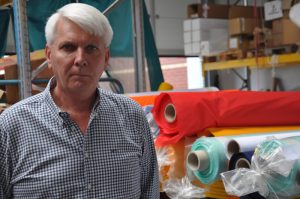
From Ajax football flags, scarfs for the André Rieu fan base, Nick & Simon pillows, oven gloves to sleep masks – you name it, Phoenext makes it. “We do just about anything except clothing,” as owner and director Jakob Lameijer points out. They relied on the transfer sublimation expertise of Mimaki dealer Texo Trade Service (TTS) and have installed the new high-speed JV150-160, on top of optimizing their Mimaki TS34-1800A. “The printer now runs at a higher speed and consumes less ink.”
“People run into our products everywhere, but hardly anyone knows we printed it. We just might be the best kept secret in this industry.” How come, one may ask. “We’re pretty small, but we have an elaborate network of resellers (dealers) that serve some of the biggest brands in the market.”
No wonder visitors could bump into the merchandising of the biggest soft drink producer or world-renowned electronics concerns in the production room in Oldenzaal. Our entire operation runs on a small team of 8 full-time employees, but our organization is very flexible, which is why we can handle big projects. Our average order size is not that big, but if Anderlecht becomes the Belgian football champion and they need 15.000 scarfs stat, we’re the ones who pull it off.
“I have yet to come across any other company that can handle such a diverse product portfolio at our speed. We can do so much in so little time.” Lameijer believes this is due to the fact that Phoenext handles everything in house. “Urgency, speed and quality prevail, this is not a responsibility we outsource to someone else.”
A 15.000 fan scarf order is no laughing matter. A fast and smart purchase of the proper material is essential, not to mention the Phoenext expertise in the production path from print, confection to textile creation.
The transfer sublimation print support
For textile prints, Phoenext relies solely on transfer sublimation print. An inverted left-to-right image is printed on sublimation paper. This paper is then transferred to paper in a calender by means of heat and pressure. This technique delivers the best quality at the highest resolution for textile printing.
Michel Prins at Mimaki textilel specialist Texo Trade Services (TTS) in Waddinxveen illustrates the difference by means of two printed pillows. “The pillow that is direct printed textile, shows a blurry cross-over between the copy and the logo. The transfer sublimation printed pillow on the other hand shows a pixel-perfect print with the sharpest of details.” Transfer sublimation is the TTS specialty. That’s why Jakob Lameijer continues to work with them after all those years. “Transfer sublimation also became our expertise over the years. And TTS provides us with all the support we need”, Lameijer confirms.

Inkmanagement
TTS supplies the Oldenzaal based company with the ink, the sublimation paper and the textiles. The increasing demand forced a capacity problem onto the company; they knew it was time to install a second printer: the Mimaki JV150-160. A logical choice, according to Prins: “You could consider the Mimaki JV150 (see side bar) as the heir to the Mimaki TS34 throne.”
But TTS went way beyond merely installing a new printer. According to Prins the Mimaki TS34 was not functioning to its optimal capacity. “The machine ran too slowly and consumed too much. The printer was actually running at too high a resolution.” Lameijer also noticed that the ink consummation was too high. “Daily refills for black prints became a daily necessity – that’s just crazy.” So aside from installing the new printer, TTS also optimized their current set-up and transferred from the Mimaki SB52- to the Mimaki SB53-inks. These Mimaki SB53 transfer sublimation inks have a high viscosity and only produce a minimal amount of volatile organic compounds. Not to mention the 20% cost reduction they offer. The Mimaki SB53-inks also carry the OEKO-TEX® approbation mark, this guarantees that the applied chemicals in the sublimation inks are not hazardous to the environment, making the ink perfectly suited for durable textile applications.
Prins: “During the installation of the new Mimaki JV150-printer we matched the colors to those of the Mimaki TS34. That was our starting point for the color management. Next we also adjusted the settings of the Mimaki TS34 to those of the Mimaki SB53-inks.”
Jakob Lameijer is not just pleased with the new printer, he also raves about the better results with the existing printer. “The printer runs at a higher speed and consumes way less ink.”
Mimaki Bulk Ink System (MBIS)
Both transfer sublimation printers at Phoenext are operating as they should, handling both smaller productions and larger orders. This is partly due to the Mimaki Bulk Ink System (MBIS) that both printers run on. It makes sure the printer does not have to refill inks as often, which enables longer, uninterrupted production runs. Some even without a supervising operator. “We consider this kind of bulk system a necessity at companies that handle so much production as Phoenext does.” Prins states.
Third printer’s a charm?
Incorporating a new Mimaki printer in the current production workflow goes flawlessly, as experience taught Prins. “The printers are different types, but they operate the same way. That’s the beauty of all Mimaki printers.”
This smooth integration is a must, because Phoenext only produces increasingly more. “Our customers see we can create more, so we get to create more. Increasingly in full color even. I once said I did not want to print at all. Look at me know, considering investing in a third printer.”
The Mimaki JV150-series is considered an affordable model, ideally suited as an entry model for both small and large textile applications. The Mimaki JV150 is a multipurpose printer that comes in two setups: direct print (sign and graphics) or a transfer sublimation printer (via sublimation paper on textile).
This article is written by Arthur Lubbers for PRStory as requested by Mimaki.

